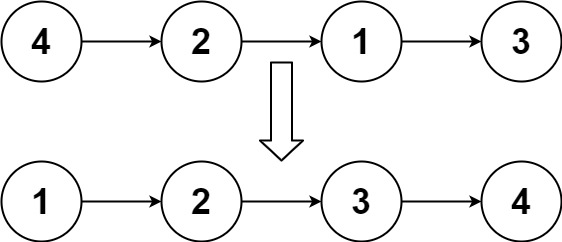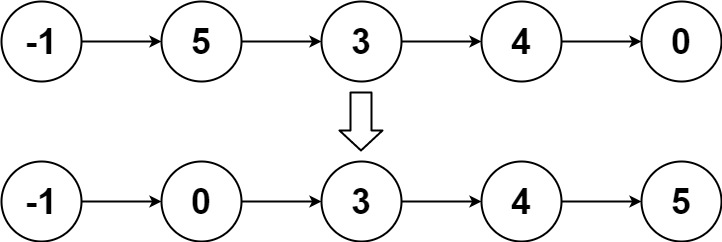Linked List - Sort List
All diagrams presented herein are original creations, meticulously designed to enhance comprehension and recall. Crafting these aids required considerable effort, and I kindly request attribution if this content is reused elsewhere.
Difficulty : Easy
Merge Sort, Find Middle, Merge Two Sorted List, Recursive
Problem
Given the head of a linked list, return the list after sorting it in ascending order.
Example 1:
1
2
Input: head = [4,2,1,3]
Output: [1,2,3,4]
Example 2:
1
2
Input: head = [-1,5,3,4,0]
Output: [-1,0,3,4,5]
Solution
Implement this using Merge Sort recursively. Here are the steps:
Find Middle Node -> Partition the List -> Repeate Until Base condition (last node) -> Merge Nodes
Base Condition
Lets define the base condition first. As per the basic Merge Sort logic we need to break down the array to individual elements before merging them back. Since here we are working with node the base condition is when a node’s next pointer is None. Only after the base condition is executed, the merge_left_and_right() function will be executed for each call stack.
1
2
if head.next is None:
return head
However the above code will fail for edge cases where input node is empty. There are two ways to resolve it, either wrap the recursive function using another function and validate the edge cases before even calling the recursive function, or extend the
ifcondition above to check forheadto beNoneas well. Rememberhead==Nonewill be only for one time input condition only. The full code at the bottom will account for this.
Find Middle (Top-Down)
Use a slow and fast pointer for implementing find_middle function. We want to select the last node of the first partition, hence setting fast to one step ahead by using head.next.
1
2
3
4
5
6
def find_middle(head):
slow, fast = head, head.next
while fast and fast.next:
slow=slow.next
fast=fast.next.next
return slow
Now lets invoke that find_middle() function.
1
last_node_of_first_half = find_middle(head)
Partition List (Top-Down)
Once we have the last node of the first partition, lets split the LinkedList in two parts.
1
2
second_head = last_node_of_first_half.next
last_node_of_first_half.next = None
We need to break the nodes till we have just one node left. So lets call sort_list() recursively for each partition.
1
2
left = sort_list(head)
right = sort_list(second_head)
Here is the stack trace. We Initialy have 4 nodes, then split that to 2 nodes for each partition. Finally there are just 4 separate indipendent nodes.
1
2
3
4
5
6
7
==> ListNode{val: 4, next: ListNode{val: 2, next: None}}, ListNode{val: 1, next: ListNode{val: 3, next: None}}
==> ListNode{val: 4, next: None}, ListNode{val: 2, next: None}
==> ListNode{val: 4, next: None}
==> ListNode{val: 2, next: None}
==> ListNode{val: 1, next: None}, ListNode{val: 3, next: None}
==> ListNode{val: 1, next: None}
==> ListNode{val: 3, next: None}
We can finally write a function to merge the left and right partitions.
1
return merge_partition(left,right)
Merge Nodes (Bottom-Up)
Since the start node is undecided, we need to start with a dummy node.
1
2
dummy = ListNone()
curr = dummy
Next, we can loop until one of the list is empty and keep extending curr pointer by comparing the values.
1
2
3
4
5
6
7
8
while left and right:
if left.val < right.val:
curr.next=left
left=left.next
else:
curr.next=right
right=right.next
curr=curr.next
In case one of the LinkedList was longer than another, we need to connect the remainig with curr.
1
2
3
4
5
6
if left:
curr.next=left
if right:
curr.next=right
return dummy.next
Final Code
Here is the full code.
1
2
3
4
5
6
7
8
9
10
11
12
13
14
15
16
17
18
19
20
21
22
23
24
25
26
27
28
29
30
31
32
33
34
35
36
37
38
39
40
41
# class ListNode:
# def __init__(self, val=0, next=None):
# self.val = val
# self.next = next
def merge_partition(left, right):
dummy = ListNode()
curr = dummy
while left and right:
if left.val < right.val:
curr.next = left
left = left.next
else:
curr.next = right
right = right.next
curr = curr.next
if left:
curr.next = left
if right:
curr.next = right
return dummy.next
def sort_list(head):
# not head is only when tested with
# input []
if not head or not head.next:
return head
last_node_of_first_half = find_middle(head)
second_head = last_node_of_first_half.next
last_node_of_first_half.next = None
left = sort_list(head)
right = sort_list(second_head)
return merge_partition(left, right)
Runtime Complexity
The runtime will be O(n) as we are simply scanning through the list once.

